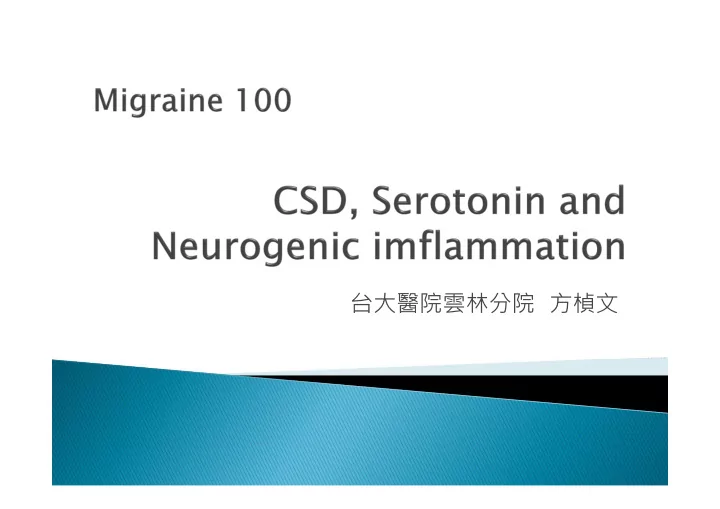

台大醫院雲林分院 方楨文
� Description of visual auras – Karl Lashley � Cortical spreading depression – Aristides Leão � Serotonin and introduction of methysergide – Wolff � Olegemia and CSD � Neuro-imflammation
� Karl Spencer Lashley (1890-1958) � Prof. of psychology in Harvard � American. � Zoologist in the early life. � Focused in psychology and comparative biology later.
� The shape of scotoma and fortification figures maintained its shape during the whole process. � From macula to blind point
� An excitatory process (scintillation) and an inhibitory process is initiated in visual cortex and spread over to neighboring area. � During the process, the activities extinguish in the initiative area. And the process of inhibition also spread with the same rate as the excitatory process. � The rate is approximately 3 mm/min. ◦ Antero-posterior length of visual striae is 67mm. ◦ It took 20 mins for the aura to spread.
� Aristides Leão (1914- 1993) � Brazilian � Prof. of Harvard
� 1944 � First noticed during stimulation of rabbit cortex. ◦ A marked, enduring, reduction of electrical activity, a reduction which appears first at the region that has been stimulated, and spreads out from that location in all directions. ◦ Recovery took 5-10 minutes.
� A wave of dilatation of pial vessals accompanied with CSD. � The CSD may be related to migraine with aura due to the slow development of scotoma and sensory symptoms. � However, he seemed unaware of Lashley’s paper and never measured the velocity of CSD. � The connection was later discussed in 1980’s.
� Syntheized in 1948 ◦ Sero-tonin – Serum vasoconstricter � Wolff et al ◦ Peri-vascular injection produced migraine symptoms. � Methysergide ◦ A derivative of LSD 25. Antagonist of serotonin.
� Serious side effects were noticed 5 years after marketing. ◦ Retroperitoneal fibrosis. – Around 1/5000. ◦ Later, cardiac and pulmonary fibrosis were also noted. ◦ Also, hallucinogenic. � Although non-successful, methysergide opened the route to further searching of serotonin antagonist.
� Vascular theory lead to studies of reduced cerebral blood flow (rCBF) ◦ 6 examined during aura and 3 into the headache stage ◦ All developed rCBF in aura stage. � CSD was related to hyperemia then. ~Olesen et al. 1981
� Later techniques (SPECT) ◦ Hyperemia in headache stage. ◦ Linked the relation of CSD.
� 1982 Lauritzen et al ◦ Hyperemia lasted several minutes after CSD, but was followed by 15-28% of oligemia for >1 hour. � First documented oligemia after CSD.
� Reduced rCBF and oligemia after CSD. ◦ Similar spreading speed. (2-3 mm/min) ◦ Similar reactivity in CO2 responses. ◦ Similarly preserved auto-regulation in BP � Also, CSD provoked plasma protein leakage within the dura mater. ◦ A “bridging” mechanism between neural activities and blood flow.
� A common therapeutic target for migraine ◦ Topiramate, Volproate, Propanolol, Amitriptyline, Methysergide all decrease CSD frequency by 40- 80%. ◦ Chronic administration is effective while acute one isn’t. � Similar activities (depressed EEG activities) were observed in brain infarction and intra- cranial hemorrhage.
� 1979. – Substance P is proposed to be released by trigeminal nerve and cause vasodilatation in migraine and cluster headache. � Substance P is located in pial and subarachinoid vessals in many other species. � Substance P may be released during neuronal afferent process and cause sterile imflammation of neighboring vessals. � It explained the ipsilateral character of migraine and other vascular headache.
� Electric stimulations of trigeminal nerve increased protein tracer in ipsilateral dura. � Ergotamine, Dihydroergotamine, Ergot alkaloid all inhibit extravasation. � All acute anti-migraine medications have proven to inhibit neurogenic protein extravasation(NPE). But drugs inhibiting NPE don’t always cure headache.
Recommend
More recommend